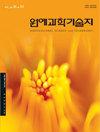Response of Photosynthetic Characteristics to Different Salicylic Acid Concentrations in Relation to Waterlogging Resistance in Zanthoxylum armatum
IF 0.8
4区 农林科学
Q3 HORTICULTURE
Korean Journal of Horticultural Science & Technology
Pub Date : 2023-08-31
DOI:10.7235/hort.20230032
引用次数: 0
Abstract
Zanthoxylum armatum (Rutaceae) is an important spice and a traditional medicinal plant in southwest China. Owing to its shallow root system, it is highly susceptible to waterlogging stress. To evaluate how an exogenous salicylic acid (SA) application reduces photosynthetic damage in Z. armatum under waterlogging stress conditions, the content of photosynthetic pigments and gas exchange and chlorophyll fluorescence parameters were studied under different SA concentrations (0, 1 and 2 mM) and different numbers of waterlogging days (1, 2 and 3 d) to identify the mechanisms underlying the seedlings’ waterlogging response. The results showed that waterlogging significantly affects the photosynthetic characteristics in leaves. An exogenous SA application increased the contents of photosynthetic pigments as well as the transpiration rate (Tr), net leaf photosynthetic rate (Pn), stomatal conductance (Gs), water use efficiency (WUE), actual quantum efficiency (ΦPSII), photosystem II (PSII) maximum quantum efficiency (Fv/Fm), PSII photochemical efficiency in light (Fv'/Fm'), and electron transport rate (ETR), whereas the treatment decreased the intercellular carbon dioxide concentration (Ci), non-photochemical quenching coefficient (NPQ) and minimum fluorescence (Fo). Therefore, the SA application helps improve the photosynthetic efficiency and reduce photodamage to Z. armatum in the event of waterlogging stress.花椒光合特性对不同水杨酸浓度的响应与抗涝性的关系
花椒(Zanthoxylum armatum)是中国西南地区重要的香料和传统药用植物。由于根系较浅,对涝渍胁迫非常敏感。为了研究外源水杨酸(SA)对涝渍胁迫下柽柳幼苗光合损伤的影响,研究了不同水杨酸浓度(0、1和2 mM)和不同涝渍天数(1、2和3 d)下水杨酸对柽柳幼苗光合色素含量、气体交换和叶绿素荧光参数的影响,探讨了水杨酸对柽柳幼苗涝渍响应的机制。结果表明,涝渍对叶片光合特性影响显著。外源SA处理增加了光合色素含量、蒸腾速率(Tr)、净叶片光合速率(Pn)、气孔导度(Gs)、水分利用效率(WUE)、实际量子效率(ΦPSII)、光系统II (PSII)最大量子效率(Fv/Fm)、PSII光化学效率(Fv'/Fm')和电子传递速率(ETR),而降低了细胞间二氧化碳浓度(Ci)。非光化学猝灭系数(NPQ)和最小荧光(Fo)。因此,在涝渍胁迫下,施SA有助于提高柽柳的光合效率,减少对柽柳的光损伤。
本文章由计算机程序翻译,如有差异,请以英文原文为准。
求助全文
约1分钟内获得全文
求助全文
来源期刊
CiteScore
2.00
自引率
0.00%
发文量
0
审稿时长
1 months
期刊介绍:
Horticultural Science and Technology (abbr. Hortic. Sci. Technol., herein ‘HST’; ISSN, 1226-8763), one of the two official journals of the Korean Society for Horticultural Science (KSHS), was launched in 1998 to provides scientific and professional publication on technology and sciences of horticultural area. As an international journal, HST is published in English and Korean, bimonthly on the last day of even number months, and indexed in ‘SCIE’, ‘SCOPUS’ and ‘CABI’. The HST is devoted for the publication of technical and academic papers and review articles on such arears as cultivation physiology, protected horticulture, postharvest technology, genetics and breeding, tissue culture and biotechnology, and other related to vegetables, fruit, ornamental, and herbal plants.

 求助内容:
求助内容: 应助结果提醒方式:
应助结果提醒方式:


